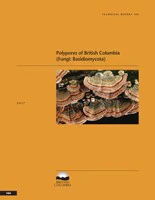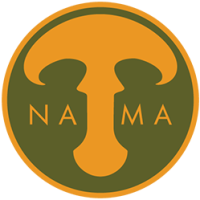Few polypores generate great interest among most mushroom hunters and so they usually are rather poorly represented in field guides (for instance, they comprise only 21 of the 465 species in Mushrooms of the Pacific Northwest). Not many are strikingly attractive, their stature and manner of fruiting make them difficult photographic subjects, and only a handful can be considered good edibles. So they get little respect, despite their great ecological importance as decomposers, pathogens, and ectomycorrhizal symbionts, and their lack of presence in field guides means they are difficult to identify for the folks who do take an interest in them. There is, of course, the technical treatment, North American Polypores, by the late Bob Gilbertson and Norwegian polypore expert Leif Ryvarden, but it is out of print and its lack photographs or other macro illustrations of the fruiting bodies is a major limitation for most of us (it is, however, loaded with drawings of microscopic features). Thus, for wannabe polypore identifiers, this new book by Canadian wood-rotter expert, Jim Ginns, will be most useful, not only in BC and the US Pacific Northwest, but farther afield, as well.
After a few pages of Abstract, Acknowledgments, and Photographic Credits, Ginns provides a brief Introduction (Purpose, Scope, Effect on Wood, Cultural Significance, Economic Impact, and Ecological Impact), an equally brief section How to Use this Report (Collecting, Microscopic Study, Identification, and Standard Format for Descriptions, followed by seven pages of excellent line drawings by Ryvarden), and a short summary of the current taxonomic arrangement of the polypores, noting that it is not the final word by any means. The back matter includes Glossary and Abbreviations, References (mostly to primary research sources), and the Index.
The meat of the book begins with a series of six keys (A through F) to genera and selected species, preceded by a key to those keys (which, at first somewhat confusingly, does not include key F — to which one is directed by three different leads in key B). The A-through-F key groups are based on presence/absence of a stipe, presence/absence of a cap, substrate, and color of the context. The keys (A through F, as well as the many keys to species that appear in the Descriptions section) include microscopic features, such as the nature of the hyphae, presence/absence of clamp connections, and spore size and shape so, while not always absolutely necessary, a microscope will come in very handy.
The Descriptions of Genera (83) and Species (207, about 42% of the currently recognized North American species) are arranged alphabetically and follow a standardized format. For genera with more than one species in BC, a genus description and key to the species precede the species descriptions. The standard format includes Current Scientific Name, Synonyms, Common (English) Name(s), Habitat, Geographic Range, and Description of the Basidiomata (Ginns uses technical terms throughout), first the macroscopic characteristics and then the microscopic ones, and each concludes with Notes that highlight distinguishing features and compare the species in question with similar ones. Although no photographs are provided for some species (less common, or less commonly noticed ones), most of the descriptions are supported by one or two photos, often a combination of overall aspect and hymenium close-up views.
The descriptions are well done. A major focus of Ginns‘s professional career has been the study of wood-rot fungi (not just the polypores), which has given him an excellent personal familiarity with most of the species and this is clear in his writing. He includes sufficient detail for identification purposes while, at the same time, being clear and concise. The photographs, most of which are about 2 × 3 inches or somewhat larger, are of uneven quality and few of them are what I would consider excellent. Part of the reason is that most polypores make poor subjects. Their typical shelf-like shapes make it difficult to show both the upper and lower surfaces simultaneously in an undisturbed shot and the sides of logs and snags don‘t provide much of a platform for up-turning one shelf to exhibit the pore surface. Many of the photos are rather dark, and comparison of the print and PDF versions suggests that, although the printing process was responsible for much of the problem, some of the original images likely were under-exposed. Nevertheless, the quality is sufficient for identification purposes.
While I think the content is spot-on, I dislike the large amount of wasted space in the layout of the book. It is large-format (8.5 × 11 inches, which is great), but the space is not utilized effectively. The left margin is nearly 3 inches wide and, in most cases, it is only used for the species name(s) and synonyms. Occasionally a photo also extends into this area. There also are many pages where large areas of white space are left at the bottoms. Using more typical margins and avoiding excess white space would have allowed the size of the photos to be increased considerably (thus increasing their utility) without adding to the page count.
In addition to providing a new tool for those mushroom hunters who are already polypore fans, I hope this book encourages other folks to learn more of these ecologically vital fungi. The print-on-demand version is competitively priced, while the free PDF is clearly a bargain. Kudos to the Provincial government for making the digital version freely available.
Review by Steve Trudell, 2017
PDF available for free download at https://www.for.gov.bc.ca/hfd/pubs/docs/TR/TR104.pdf.


NAMA Store >